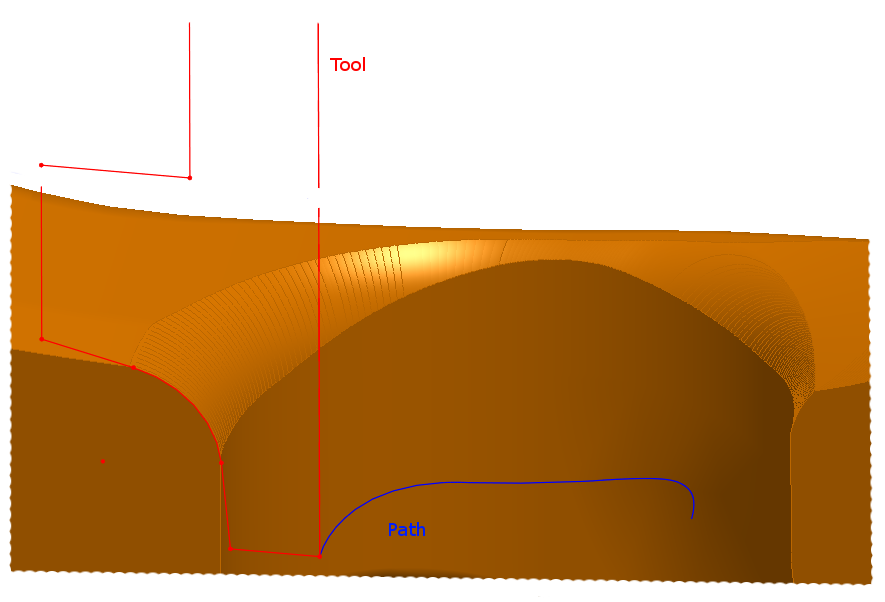Community Tip - Learn all about the Community Ranking System, a fun gamification element of the PTC Community. X
- Community
- Creo+ and Creo Parametric
- Manufacturing (CAM)
- Re: How to represent a milling along a 3D path
- Subscribe to RSS Feed
- Mark Topic as New
- Mark Topic as Read
- Float this Topic for Current User
- Bookmark
- Subscribe
- Mute
- Printer Friendly Page
How to represent a milling along a 3D path
- Mark as New
- Bookmark
- Subscribe
- Mute
- Subscribe to RSS Feed
- Permalink
- Notify Moderator
How to represent a milling along a 3D path
Hello,
I would like to represent a milling with a special tool and along a 3D path. The only way I found is to create a repetition of substraction of the tool along the path but is not very clean.
Do you have an idea how to do that ?

Thanks in advance,
Regards
PS : I work on WF4
This thread is inactive and closed by the PTC Community Management Team. If you would like to provide a reply and re-open this thread, please notify the moderator and reference the thread. You may also use "Start a topic" button to ask a new question. Please be sure to include what version of the PTC product you are using so another community member knowledgeable about your version may be able to assist.
- Mark as New
- Bookmark
- Subscribe
- Mute
- Subscribe to RSS Feed
- Permalink
- Notify Moderator
There is no straight forward tool for this : regular Sweep tools only address flat sections, while in true material removal cutting curve is anything but flat.
In some particular cases you can simulate true tool path though, especially if we talk 3 axis milling. This require quite extensive surfacing work, but the guidelines might be :
1. Define mill axis path by 2 curves (one passing through the tip of the mill, another - passing through some point on its axis)
2. Make boundary blend between these curves
3. use normal offset of this blen to both sides, with offset = R of the tool. With sime luck, these normal offsets wil emulate very close the true material removal boundaries.
4. close this path from the bottom side (either by another blend, or by full round - if this is ball mill).
5. Merge all surfaces and solidify them. If it all succeeds you may get a "negative" side, that you will need to just subtract from your material.
This worked for me once building spiral flute for a drill, hope this will work for your case too ...
Best
- Vlad
- Mark as New
- Bookmark
- Subscribe
- Mute
- Subscribe to RSS Feed
- Permalink
- Notify Moderator
Thank you for your answer, I'll try it.
Regards
- Mark as New
- Bookmark
- Subscribe
- Mute
- Subscribe to RSS Feed
- Permalink
- Notify Moderator
One more item I forgot to mention : given construction of this "negative" part is quite a task by itself, it is much easier to make it as a separate "material removal" part, and then locate vs. material and perform cutout. If you try to work in the same part you will face more problems in quilts work / solidification than working in an empty part.
- Mark as New
- Bookmark
- Subscribe
- Mute
- Subscribe to RSS Feed
- Permalink
- Notify Moderator
This is one area where SolidQuirks is actually better. You can sweep a revolved solid along a trajectory, more accurately simulating the path of a rotating cutting tool.
We've needed this for a long time, I've run into issues because of this.
Actually, in looking at your geometry, a simple swept cut should work. Your trajectory looks planar.
- Mark as New
- Bookmark
- Subscribe
- Mute
- Subscribe to RSS Feed
- Permalink
- Notify Moderator
Thank you but my trajectory is not planar...
What is "SolidQuirks" ?
- Mark as New
- Bookmark
- Subscribe
- Mute
- Subscribe to RSS Feed
- Permalink
- Notify Moderator
Ahh, it looked like it was. In that case, you could do a pattern of sections (put points at a relative position on the curve, pattern the points, then reference pattern the curves), and do a blend thru the sections. While this won't be perfect, it'll be real close, especially if there's a bunch of sections.
Oh, and "SolidQuirks" is a jab at "SolidWorks" CAD software. ![]()
Good luck!
- Mark as New
- Bookmark
- Subscribe
- Mute
- Subscribe to RSS Feed
- Permalink
- Notify Moderator
For me it doesn't work because it don't take account of milling tool volume in each section...
Thank you for your time.
- Mark as New
- Bookmark
- Subscribe
- Mute
- Subscribe to RSS Feed
- Permalink
- Notify Moderator
Fully agree with you Frank. Hope we will have this also.
And better looking at a tool profile above - my proposed technique will be not easy to use here (it is more for simple profile, end or ball mills). To use it for more profiled tools like above several normal offsets will need to be created (on different Z), connected between them by blends and later rounded.
Still the result will be way more accurate than any attempt to sweep planar section ... proven.
p.s. really for linear trajectiry sweep can be used - but only for linear one.





